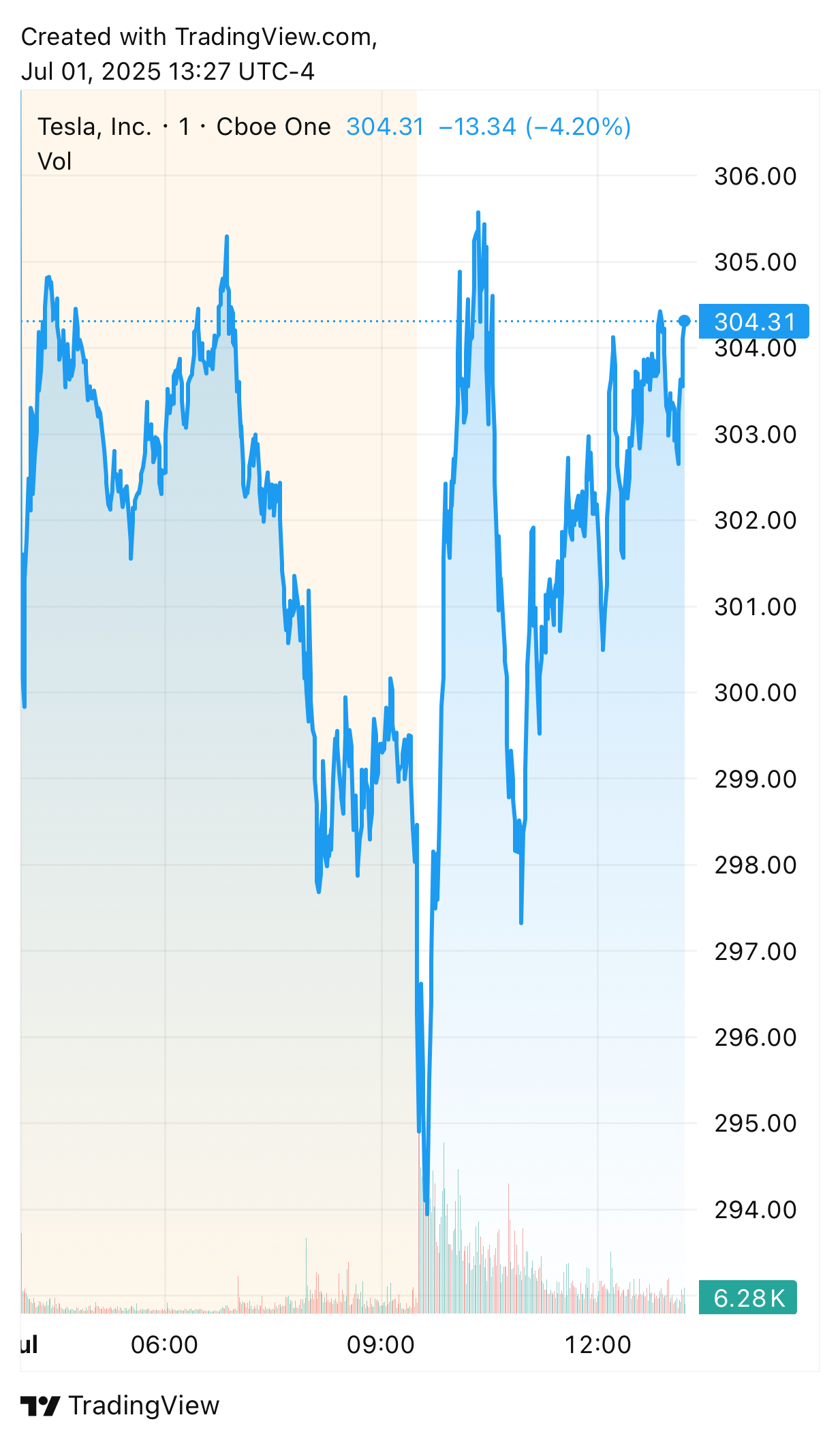As of 01:25 AM HKT on Wednesday, July 2, 2025, Tesla, Inc. (TSLA) finds itself at a critical juncture, with its stock price experiencing a significant downturn that has erased substantial market value. Since peaking at $479.86 on December 17, 2024, Tesla’s shares have plummeted over 50%, wiping out approximately $800 billion in market capitalization. This report examines the multifaceted reasons behind the 2025 Tesla stock crash, including declining sales, leadership challenges, geopolitical tensions, and shifting investor sentiment, while assessing the company’s future prospects.
Declining Sales and Market Share Erosion
The most immediate driver of Tesla’s stock decline has been a marked reduction in vehicle deliveries. In the first quarter of 2025, Tesla reported delivering 336,681 units, a 13% year-over-year decrease, marking its worst quarterly performance since 2022. This downturn extends across key markets: Europe saw a 45% drop in registrations, China experienced a 14% decline, and the United States noted a 3% reduction. The global rise in electric vehicle (EV) sales, up 21% in January 2025 according to Bank of America, contrasts sharply with Tesla’s struggles, highlighting a loss of market dominance. Competitors such as BYD, which offers models like the Seagull at $10,000, and legacy automakers like Volkswagen, which outsold Tesla in EV sales outside China in January, are eroding Tesla’s position. This sales slump, coupled with price cuts that have reduced revenue per vehicle from $56,000 in mid-2022 to under $40,000 in recent quarters, has pressured profitability, with operating profit falling 23% to $1.6 billion in Q4 2024.
Leadership and Brand Reputation Challenges
At the heart of Tesla’s woes lies the polarizing figure of CEO Elon Musk. His high-profile role as an advisor in the Trump administration, particularly as head of the Department of Government Efficiency (DOGE), has coincided with the stock’s seven-week losing streak since early 2025. Musk’s political engagement, including his endorsement of far-right parties in Europe and controversial rhetoric on X, has alienated a significant portion of Tesla’s customer base. Reports of vandalism against Tesla properties and a 76% sales decline in Germany, Europe’s largest car market, underscore this brand erosion. Additionally, Musk’s divided attention across Tesla, SpaceX, xAI, and X has raised concerns about his capacity to steer the company. The departure of key executives, such as Wes Baglino and Zach Kirkhorn, further signals internal instability, with investors questioning the feasibility of Musk’s ambitious deadlines, such as the June 2025 robotaxi launch in Austin.
Geopolitical and Regulatory Pressures
Geopolitical tensions have exacerbated Tesla’s challenges. The Trump administration’s proposed elimination of the $7,500 EV tax credit by late 2025 threatens to reduce demand, potentially costing Tesla $1.2 billion annually in profits. Tariffs on imported parts, a 25% levy on components from Canada and Mexico, and strained U.S.-China relations pose risks to Tesla’s Shanghai factory, which supplies global markets. The National Highway Traffic Safety Administration (NHTSA) is also investigating Tesla’s Full Self-Driving (FSD) system following a fatal crash in Arizona in 2023, raising safety concerns that could delay regulatory approvals. These factors, combined with Musk’s public feud with Trump over tax legislation in June 2025—resulting in a $152 billion market value loss in a single day—have intensified market uncertainty.
Valuation Concerns and Investor Sentiment
Tesla’s valuation remains a contentious issue. Trading at a forward price-to-earnings (P/E) ratio of 65 times as of early 2025, it exceeds the S&P 500’s multiple by over three times and dwarfs competitors like Nvidia at 20 times earnings. Analysts such as Ross Gerber have argued that Tesla’s earnings per share, projected at $2.75 for 2025 (down from $6 estimated in 2023), do not justify this premium, especially amid a 52% earnings drop in 2024. The stock’s meme-like behavior, with a 20% surge following dismal Q1 earnings, reflects speculative trading rather than fundamentals. High-profile investors like Dan Ives have revised price targets from $600 to $315, citing “permanent brand destruction” if Musk fails to refocus, while Cathie Wood’s $2,600 target appears increasingly detached from reality.
Future Outlook and Strategic Implications
Despite the crash, Tesla retains long-term potential through innovations like the Cybercab robotaxi and Optimus humanoid robot, which Musk envisions as multitrillion-dollar opportunities. The June 2025 robotaxi launch in Austin could be a turning point if successful, though skepticism persists due to Tesla’s vision-only approach lacking LIDAR, unlike Waymo’s established system. However, the company faces immediate hurdles: declining used car values, intensified competition, and a need for new leadership to restore credibility. Investors are divided—some see a buying opportunity at current levels (around $225), while others anticipate further declines to $120-$150, as predicted by JP Morgan and Wells Fargo.
Conclusion
The 2025 Tesla stock crash reflects a convergence of operational, reputational, and macroeconomic challenges, amplified by Musk’s polarizing leadership. While Tesla’s technological edge and brand loyalty offer a foundation for recovery, the path forward requires addressing sales stagnation, regulatory risks, and valuation misalignment. For investors, the decision to buy the dip hinges on faith in Musk’s vision versus the sobering reality of current fundamentals. As the company approaches its Q2 delivery data in July 2025, the market will closely watch whether Tesla can navigate this crisis or face deeper losses.
